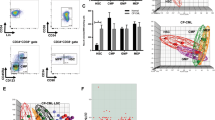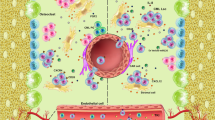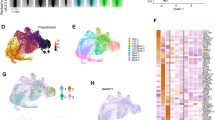Abstract
The leukemic stem cells in patients with chronic myeloid leukemia (CML) are well known to be clinically resistant to conventional chemotherapy and may also be relatively resistant to BCR-ABL-targeted drugs. Here we show that the lesser effect of imatinib mesylate (IM) on the 3-week output of cells produced in vitro from lin−CD34+CD38− CML (stem) cells compared with cultures initiated with the CD38+ subset of lin−CD34+ cells is markedly enhanced (>10-fold) when conditions of reduced growth factor stimulation are used. Quantitative analysis of genes expressed in these different CML subsets revealed a differentiation-associated decrease in IL-3 and G-CSF transcripts, a much more profound decrease in expression of BCR-ABL than predicted by changes in BCR expression, decreasing expression of ABCB1/MDR and ABCG2 and increasing expression of OCT1. p210BCR-ABL and kinase activity were also higher in the lin−CD34+CD38− cells and formal evidence that increasing BCR-ABL expression decreases IM sensitivity was obtained from experiments with a cell line model. Nevertheless, within the entire CD34+ subset of CML cells, BCR-ABL expression was not strongly affected by changes in cell cycle status. Taken together, these results provide the first evidence of multiple mechanisms of innate IM resistance in primitive and quiescent CML cells.
This is a preview of subscription content, access via your institution
Access options
Subscribe to this journal
Receive 12 print issues and online access
$259.00 per year
only $21.58 per issue
Buy this article
- Purchase on Springer Link
- Instant access to full article PDF
Prices may be subject to local taxes which are calculated during checkout








Similar content being viewed by others
References
Goldman JM, Melo JV . Chronic myeloid leukemia – advances in biology and new approaches to treatment. N Engl J Med 2003; 349: 1451–1464.
Lugo TG, Pendergast AM, Muller AJ, Witte ON . Tyrosine kinase activity and transformation potency of bcr-abl oncogene products. Science 1990; 247: 1079–1082.
Holyoake TL, Jiang X, Drummond MW, Eaves AC, Eaves CJ . Elucidating critical mechanisms of deregulated stem cell turnover in the chronic phase of chronic myeloid leukemia. Leukemia 2002; 16: 549–558.
Penserga ET, Skorski T . Fusion tyrosine kinases: a result and cause of genomic instability. Oncogene 2007; 4: 11–20.
Dube ID, Arlin ZA, Kalousek DK, Eaves CJ, Eaves AC . Nonclonal hemopoietic progenitor cells detected in long-term marrow cultures from a Turner syndrome mosaic with chronic myeloid leukemia. Blood 1984; 64: 1284–1287.
Hogge DE, Coulombel L, Kalousek DK, Eaves CJ, Eaves AC . Nonclonal hemopoietic progenitors in a G6PD heterozygote with chronic myelogenous leukemia revealed after long-term marrow culture. Am J Hematol 1987; 24: 389–394.
Eaves CJ, Eaves AC . Progenitor cell dynamics. In: Carella AM, Daley GQ, Eaves CJ, Goldman JM, Hehlmann R (eds). Chronic Myeloid Leukemia: Biology & Treatment. Martin Dunitz: London, 2001, pp. 73–100.
Druker BJ, Tamura S, Buchdunger E, Ohno S, Segal GM, Fanning S et al. Effects of a selective inhibitor of the Abl tyrosine kinase on the growth of Bcr-Abl positive cells. Nat Med 1996; 2: 561–566.
Shah NP, Tran C, Lee FY, Chen P, Norris D, Sawyers CL . Overriding imatinib resistance with a novel ABL kinase inhibitor. Science 2004; 305: 399–401.
Carter TA, Wodicka LM, Shah NP, Velasco AM, Fabian MA, Treiber DK et al. Inhibition of drug-resistant mutants of ABL, KIT, and EGF receptor kinases. Proc Natl Acad Sci USA 2005; 102: 11011–11016.
Weisberg E, Manley PW, Breitenstein W, Bruggen J, Cowan-Jacob SW, Ray A et al. Characterization of AMN107, a selective inhibitor of native and mutant Bcr-Abl. Cancer Cell 2005; 7: 129–141.
Graham SM, Jorgensen HG, Allan E, Pearson C, Alcorn MJ, Richmond L et al. Primitive, quiescent, Philadelphia-positive stem cells from patients with chronic myeloid leukemia are insensitive to STI571 in vitro. Blood 2002; 99: 319–325.
Holtz MS, Slovak ML, Zhang F, Sawyers CL, Forman SJ, Bhatia R . Imatinib mesylate (STI571) inhibits growth of primitive malignant progenitors in chronic myelogenous leukemia through reversal of abnormally increased proliferation. Blood 2002; 99: 3792–3800.
Bhatia R, Holtz M, Niu N, Gray R, Snyder DS, Sawyers CL et al. Persistence of malignant hematopoietic progenitors in chronic myelogenous leukemia patients in complete cytogenetic remission following imatinib mesylate treatment. Blood 2003; 101: 4701–4707.
Copland M, Hamilton A, Elrick LJ, Baird JW, Allan EK, Jordanides N et al. Dasatinib (BMS-354825) targets an earlier progenitor population than imatinib in primary CML, but does not eliminate the quiescent fraction. Blood 2006; 107: 4532–4539.
Holyoake TL, Jiang X, Jorgensen HG, Graham S, Alcorn MJ, Laird C et al. Primitive quiescent leukemic cells from patients with chronic myeloid leukemia spontaneously initiate factor-independent growth in vitro in association with up-regulation of expression of interleukin-3. Blood 2001; 97: 720–728.
Jiang X, Lopez A, Holyoake T, Eaves A, Eaves C . Autocrine production and action of IL-3 and granulocyte colony-stimulating factor in chronic myeloid leukemia. Proc Natl Acad Sci USA 1999; 96: 12804–12809.
Holyoake T, Jiang X, Eaves C, Eaves A . Isolation of a highly quiescent subpopulation of primitive leukemic cells in chronic myeloid leukemia. Blood 1999; 94: 2056–2064.
Dugray A, Geay JF, Foudi A, Bonnet ML, Vainchenker W, Wendling F et al. Rapid generation of a tetracycline-inducible BCR-ABL defective retrovirus using a single autoregulatory retroviral cassette. Leukemia 2001; 15: 1658–1662.
Jiang X, Ng E, Yip C, Eisterer W, Chalandon Y, Stuible M et al. Primitive interleukin 3 null hematopoietic cells transduced with BCR-ABL show accelerated loss after culture of factor-independence in vitro and leukemogenic activity in vivo. Blood 2002; 100: 3731–3740.
Jiang X, Zhao Y, Chan WY, Vercauteren S, Pang E, Kennedy S et al. Deregulated expression in Ph+ human leukemias of AHI-1, a gene activated by insertional mutagenesis in mouse models of leukemia. Blood 2004; 103: 3897–3904.
Pfaffl MW . A new mathematical model for relative quantification in real-time RT-PCR. Nucleic Acids Res 2001; 29: e45.
Dorsey JF, Cunnick JM, Lanehart R, Huang M, Kraker AJ, Bhalla KN et al. Interleukin-3 protects Bcr-Abl-transformed hematopoietic progenitor cells from apoptosis induced by Bcr-Abl tyrosine kinase inhibitors. Leukemia 2002; 16: 1589–1595.
Jiang X, Fujisaki T, Nicolini F, Berger M, Holyoake T, Eisterer W et al. Autonomous multi-lineage differentiation in vitro of primitive CD34+ cells from patients with chronic myeloid leukemia. Leukemia 2000; 14: 1112–1121.
Jamieson CH, Ailles LE, Dylla SJ, Muijtjens M, Jones C, Zehnder JL et al. Granulocyte-macrophage progenitors as candidate leukemic stem cells in blast-crisis CML. N Engl J Med 2004; 351: 657–667.
Barnes DJ, Palaiologou D, Panousopoulou E, Schultheis B, Yong AS, Wong A et al. Bcr-Abl expression levels determine the rate of development of resistance to imatinib mesylate in chronic myeloid leukemia. Cancer Res 2005; 65: 8912–8919.
ten Hoeve J, Arlinghaus RB, Guo JQ, Heisterkamp N, Groffen J . Tyrosine phosphorylation of CRKL in Philadelphia+ leukemia. Blood 1994; 84: 1731–1736.
Hamilton A, Elrick L, Myssina S, Copland M, Jorgensen H, Melo JV et al. BCR-ABL activity and its response to drugs can be determined in CD34+ CML stem cells by CrkL phosphorylation status using flow cytometry. Leukemia 2006; 20: 1035–1039.
White DL, Saunders VA, Dang P, Engler J, Zannettino AC, Cambareri AC et al. OCT-1 mediated influx is a key determinant of the intracellular uptake of imatinib but not nilotinib (AMN107); reduced OCT-1 activity is the cause of low in vitro sensitivity to imatinib. Blood 2006; 108: 697–704.
Thomas J, Wang L, Clark RE, Pirmohamed M . Active transport of imatinib into and out of cells: implications for drug resistance. Blood 2004; 104: 3739–3745.
Lepper ER, Nooter K, Verweij J, Acharya MR, Figg WD, Sparreboom A . Mechanisms of resistance to anticancer drugs: the role of the polymorphic ABC transporters ABCB1 and ABCG2. Pharmacogenomics 2005; 6: 115–138.
Scharenberg CW, Harkey MA, Torok-Storb B . The ABCG2 transporter is an efficient Hoechst 33342 efflux pump and is preferentially expressed by immature human hematopoietic progenitors. Blood 2002; 99: 507–512.
Mahon FX, Belloc F, Lagarde V, Chollet C, Moreau-Gaudry F, Reiffers J et al. MDR1 gene overexpression confers resistance to imatinib mesylate in leukemia cell line models. Blood 2003; 101: 2368–2373.
Druker BJ, Talpaz M, Resta DJ, Peng B, Buchdunger E, Ford JM et al. Efficacy and safety of a specific inhibitor of the BCR-ABL tyrosine kinase in chronic myeloid leukemia. N Engl J Med 2001; 344: 1031–1037.
Kantarjian H, Sawyers C, Hochhaus A, Guilhot F, Schiffer C, Gambacorti-Passerini C et al. Hematologic and cytogenetic responses to imatinib mesylate in chronic myelogenous leukemia. N Engl J Med 2002; 346: 645–652.
Nowell PC . Progress with chronic myelogenous leukemia: a personal perspective over four decades. Annu Rev Med 2002; 53: 1–13.
Hughes TP, Kaeda J, Branford S, Rudzki Z, Hochhaus A, Hensley ML et al. Frequency of major molecular responses to imatinib or interferon alfa plus cytarabine in newly diagnosed chronic myeloid leukemia. N Engl J Med 2003; 349: 1423–1432.
Branford S, Rudzki Z, Walsh S, Parkinson I, Grigg A, Szer J et al. Detection of BCR-ABL mutations in patients with CML treated with imatinib is virtually always accompanied by clinical resistance, and mutations in the ATP phosphate-binding loop (P-loop) are associated with a poor prognosis. Blood 2003; 102: 276–283.
Deininger M, Buchdunger E, Druker BJ . The development of imatinib as a therapeutic agent for chronic myeloid leukemia. Blood 2005; 105: 2640–2653.
Gorre ME, Mohammed M, Ellwood K, Hsu N, Paquette R, Rao PN et al. Clinical resistance to STI-571 cancer therapy caused by BCR-ABL gene mutation or amplification. Science 2001; 293: 876–880.
Shah NP, Nicoll JM, Nagar B, Gorre ME, Paquette RL, Kuriyan J et al. Multiple BCR-ABL kinase domain mutations confer polyclonal resistance to the tyrosine kinase inhibitor imatinib (STI571) in chronic phase and blast crisis chronic myeloid leukemia. Cancer Cell 2002; 2: 117–125.
Chu S, Xu H, Shah NP, Snyder DS, Forman SJ, Sawyers CL et al. Detection of BCR-ABL kinase mutations in CD34+ cells from chronic myelogenous leukemia patients in complete cytogenetic remission on imatinib mesylate treatment. Blood 2005; 105: 2093–2098.
Li S, Ilaria RL, Million RP, Daley GQ, Van Etten RA . The p190, p210, and p230 forms of the BCR/ABL oncogene induce a similar chronic myeloid leukemia-like syndrome in mice but have different lymphoid leukemogenic activity. J Exp Med 1999; 189: 1399–1412.
Chalandon Y, Jiang X, Loutet S, Eaves AC, Eaves CJ . Growth autonomy and lineage switching in BCR-ABL-transduced human cord blood cells depend on different functional domains of BCR-ABL. Leukemia 2004; 18: 1006–1012.
Crossman LC, Druker BJ, Deininger MW, Pirmohamed M, Wang L, Clark RE . hOCT 1 and resistance to imatinib. Blood 2005; 106: 1133–1134.
Jordanides NE, Jorgensen HG, Holyoake TL, Mountford JC . Functional ABCG2 is over-expressed on primary CML CD34+ cells and is inhibited by imatinib mesylate. Blood 2006; 108: 1370–1373.
Ozvegy-Laczka C, Hegedus T, Varady G, Ujhelly O, Schuetz JD, Varadi A et al. High-affinity interaction of tyrosine kinase inhibitors with the ABCG2 multidrug transporter. Mol Pharmacol 2004; 65: 1485–1495.
Burger H, van Tol H, Boersma AW, Brok M, Wiemer EA, Stoter G et al. Imatinib mesylate (STI571) is a substrate for the breast cancer resistance protein (BCRP)/ABCG2 drug pump. Blood 2004; 104: 2940–2942.
Burger H, van Tol H, Brok M, Wiemer EA, de Bruijn EA, Guetens G et al. Chronic imatinib mesylate exposure leads to reduced intracellular drug accumulation by induction of the ABCG2 (BCRP) and ABCB1 (MDR1) drug transport pumps. Cancer Biol Ther 2005; 4: 747–752.
Zhou S, Scheutz JD, Bunting KD, Colapietro A-M, Sampath J, Morris JJ et al. The ABC transporter Bcrp1/ABCG2 is expressed in a wide variety of stem cells and is a molecular determinant of the side-population phenotype. Nat Med 2001; 7: 1028–1034.
Hogge DE, Lansdorp PM, Reid D, Gerhard B, Eaves CJ . Enhanced detection, maintenance and differentiation of primitive human hematopoietic cells in cultures containing murine fibroblasts engineered to produce human Steel factor, interleukin-3 and granulocyte colony-stimulating factor. Blood 1996; 88: 3765–3773.
Fraser C, Eaves CJ, Kalousek DK . Fluorodeoxyuridine synchronization of hemopoietic colonies. Cancer Genet Cytogenet 1987; 24: 1–6.
Acknowledgements
We thank Drs M Beran (MD Anderson Cancer Center, Houston, TX, USA), M Caligiuri (Ohio StateUniversity, Columbus, Oh, USA), T Holyoake (University of Glasgow, Glasgow, UK), A Petzer (Barmherzigen Schwestern Linz Hospital, Linz, Austria), and M Barnett, D Forrest, D Hogge, J Lavoie, S Nantel, T Nevill, John Shepherd, K Song, H Sutherland and C Toze (Leukemia/BMT Program of British Columbia, Vancouver, BC, Canada) for providing patient samples; K Lambie, G Shaw, K Saw, L Zhou, W Y Chan and E Pang for excellent technical assistance; the Terry Fox Laboratory FACS Facility for assistance in cell sorting; the Stem Cell Assay Laboratory for cell processing and cryopreservation of normal and CML samples; D Wytrykush for assistance in preparing the paper; Dr P Lansdorp (Terry Fox Laboratory) and StemCell Technologies (Vancouver, BC, Canada) for antibodies and culture reagents, and Novartis (Basel, Switzerland) for the IM.
This work was supported in part by grants from the Cancer Research Society and the Leukemia & Lymphoma Society of Canada (to XJ), from the National Cancer Institute of Canada (with funds from the Canadian Cancer Society and the Terry Fox Foundation to AE, XJ and CE) and Genome British Columbia and the NIH (to AE and CE). X Jiang is a Michael Smith Foundation for Health Research Scholar. Y Zhao was a recipient of a Stem Cell Network Fellowship and a Leukemia & Lymphoma Society of Canada Fellowship.
Author information
Authors and Affiliations
Corresponding author
Additional information
Supplementary Information accompanies the paper on the Leukemia website (http://www.nature.com/leu)
Rights and permissions
About this article
Cite this article
Jiang, X., Zhao, Y., Smith, C. et al. Chronic myeloid leukemia stem cells possess multiple unique features of resistance to BCR-ABL targeted therapies. Leukemia 21, 926–935 (2007). https://doi.org/10.1038/sj.leu.2404609
Received:
Revised:
Accepted:
Published:
Issue Date:
DOI: https://doi.org/10.1038/sj.leu.2404609
Keywords
This article is cited by
-
miR-181a plays the tumor-suppressor role in chronic myeloid leukemia CD34 + cells partially via SERPINE1
Cellular and Molecular Life Sciences (2024)
-
Pathogenesis and management of accelerated and blast phases of chronic myeloid leukemia
Leukemia (2023)
-
Identification of multivariable microRNA and clinical biomarker panels to predict imatinib response in chronic myeloid leukemia at diagnosis
Leukemia (2023)
-
Identification of key microRNAs as predictive biomarkers of Nilotinib response in chronic myeloid leukemia: a sub-analysis of the ENESTxtnd clinical trial
Leukemia (2022)
-
Therapy Resistance and Disease Progression in CML: Mechanistic Links and Therapeutic Strategies
Current Hematologic Malignancy Reports (2022)



